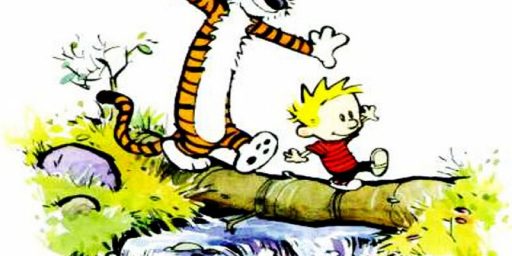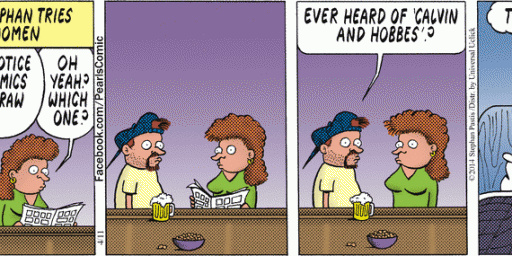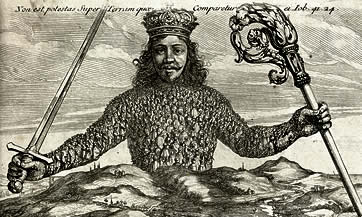‘Calvin and Hobbes’ Creator Bill Waterson Keeps Privacy
The AP has a “where are they now” feature on Bill Waterson, the man behind one of my favorite comic strips of all time, “Calvin and Hobbes.”
‘Calvin and Hobbes’ Creator Keeps Privacy
Maybe someday, officials will put up a statue marking this quaint village as the birthplace of “Calvin and Hobbes.” Just don’t expect cartoonist Bill Watterson to attend the unveiling ceremony. It’s been nearly 10 years since he abruptly quit drawing one of the most popular comic strips of all time. Since then, he’s been as absent as the precocious Calvin and his pet tiger, err, stuffed animal, Hobbes.
[…]
So what’s Watterson been up to since ending “Calvin and Hobbes?” It’s tough to say. His parents will say only that he’s happy, but they won’t say where he lives, and the cartoonist could not be reached for an interview. His former editor, Lee Salem, also remains mum, saying only that as a painter Watterson started with watercolors and has evolved to oils. “He’s in a financial position where he doesn’t need to meet the deadlines anymore,” Salem says.
[…]
Bill Watterson, 47, hasn’t made a public appearance since he delivered the commencement speech in 1990 at his alma mater, Kenyon College. But he recently welcomed some written questions from fans to promote the Oct. 4 release of the three-volume “The Complete Calvin and Hobbes,” which contains every one of the 3,160 strips printed during its 10-year run.
[…]
Salem, who edited thousands of “Calvin and Hobbes” strips at Universal Press Syndicate, says that Watterson is private and media shy, not a recluse. Salem didn’t want to see the strip end, but understood Watterson’s decision. “He came to a point where he thought he had no more to give to the characters,” Salem says.
“Calvin and Hobbes” appeared in more than 2,400 newspapers during its run, one of the few strips to reach an audience that large. Its success was rooted in the freshness of Calvin — an imaginative 6-year-old who has the immaturity of a child and the psychological complexity of a 40-year-old. As for Hobbes, the device of Calvin viewing him as alive and everybody else seeing him as a stuffed animal was simply brilliant, Salem says. Their all-encompassing bond of friendship — being able to share joy and have fun together, yet get angry and frustrated with one another — was another reason for the strip’s success.
Universal would welcome Watterson back along with “Calvin and Hobbes” or any other characters he dreams up. “He knows the door’s open and he knows where we are,” Salem says.
[…]
As a child, Watterson knew he would be an astronaut or a cartoonist. “I kept my options open until seventh grade, but when I stopped understanding math and science, my choice was made,” he wrote in the introduction to “The Complete Calvin and Hobbes.”
He loved “Peanuts” as a child and started drawing comics. He majored in political science at Kenyon. Thinking he could blend the two subjects, he became a political cartoonist but was fired from his first job at the Cincinnati Post after a few months. So he took a job designing car and grocery ads, but continued cartooning, even though several strip ideas were rejected. But Universal liked “Calvin and Hobbes” and launched its run Nov. 18, 1985, in 35 newspapers. Calvin caught Hobbes in a tiger trap with a tuna sandwich in the first strip. He spent the next 10 years driving his parents crazy, annoying his crush, Susie Derkins, and playing make-believe as his alter egos Spaceman Spiff and Stupendous Man.
[…]
Watterson ended the strip on Dec. 31, 1995, with a statement: “I believe I’ve done what I can do within the constraints of daily deadlines and small panels. I am eager to work at a more thoughtful pace, with fewer artistic compromises.”
The last strip shows Calvin and Hobbes sledding off after a new fallen snow. “It’s a magical world, Hobbes, ol’ buddy … let’s go exploring!” Calvin says in the final two panels.
Fans cried out in letters for Watterson to change his mind. Some, like Watterson’s parents, say the funny pages haven’t been the same since. “It was like getting a letter from home,” Jim Watterson says of reading his son’s work each morning.
People continue to ask the Wattersons if their son will ever send Calvin and his buddy Hobbes on new adventures. “He might draw something else, but he won’t do that again,” Kathryn Watterson says.
Truly a shame. The good news is he went out on top. Unlike, say, “Peanuts,” most of the strips were funny through the end. And it’s rare for a cartoonist to retire and come back to produce something even approaching the quality of the strip that made them famous. Neither Gary Larson (“Far Side”) nor Berkeley Breathed (“Bloom County”) , who along with Scott Adams (“Dilbert”) are the best daily panel strip cartoonists of my era, managed.






“Truly a shame. The good news is he went out on top.”
I agree on both counts. I have several Calvin & Hobbes books and enjoy them just as much today as when I first looked at them.
There was a rumor for a while that “Frazz” was actually done by Bill Watterson, and that “Jef Mallett” was a pseudonym. The main character looks a LOT like a grown-up (well, older) Calvin, has many of his personality quirks, and Caulfield is a LOT like Calvin himself. The art style is also very, very similar. Unfortunately, Frazz’ sweetheart, Miss Plainwell, probably isn’t Suzy Derkins, and Hobbes is nowhere to be found, but most fans of Calvin and Hobbes ought to enjoy Frazz.
J.
He lives in Cleveland proper. Been there. Done that. He’d be better off in Poca, West Virginia 🙂
This article has been done before, most recently in 2003 (I mentioned it here at the time. Apparently, he still lives in his hometown and spends a lot of time painting.
Of course, it’s not like cartoonists are celebrities anyway. Perhaps the most famous current cartoonist is Garry Trudeau or Breathed, neither of whom I’d recognize if they passed me on the street.
That’s part of the reason Frazz is on my daily online reading list. At the very, very least, Mallett has been greatly inspired by “Calvin and Hobbes.”